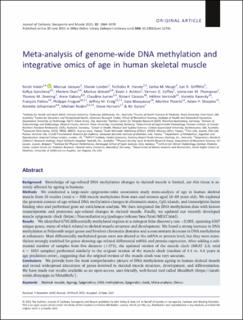| dc.contributor.author | Voisin, Sarah | |
| dc.contributor.author | Jacques, Macsue | |
| dc.contributor.author | Landen, Shanie | |
| dc.contributor.author | Harvey, Nicholas R. | |
| dc.contributor.author | Haupt, Larisa M. | |
| dc.contributor.author | Griffiths, Lyn R. | |
| dc.contributor.author | Gancheva, Sofiya | |
| dc.contributor.author | Ouni, Meriem | |
| dc.contributor.author | Jähnert, Marcus | |
| dc.contributor.author | Ashton, Kevin J. | |
| dc.contributor.author | Coffey, Vernon G. | |
| dc.contributor.author | Thompson, Jamie-Lee M. | |
| dc.contributor.author | Doering, Thomas M. | |
| dc.contributor.author | Gabory, Anne | |
| dc.contributor.author | Junien, Claudine | |
| dc.contributor.author | Caiazzo, Robert | |
| dc.contributor.author | Verkindt, Hélène | |
| dc.contributor.author | Raverdy, Violetta | |
| dc.contributor.author | Pattou, Francois | |
| dc.contributor.author | Froguel, Philippe | |
| dc.contributor.author | Blocquiaux, Sara | |
| dc.contributor.author | Thomis, Martine | |
| dc.contributor.author | Roden, Michael | |
| dc.contributor.author | Horvath, Steve | |
| dc.contributor.author | Eynon, Nir | |
| dc.contributor.author | Craig, Jeffrey M. | |
| dc.contributor.author | Sharples, Adam P. | |
| dc.contributor.author | Schürmann, Annette | |
| dc.date.accessioned | 2021-12-09T08:38:26Z | |
| dc.date.available | 2021-12-09T08:38:26Z | |
| dc.date.created | 2020-10-14T12:42:25Z | |
| dc.date.issued | 2021 | |
| dc.identifier.citation | Journal of Cachexia, Sarcopenia and Muscle. 2021, 12(4), 1064-1078. | en_US |
| dc.identifier.issn | 2190-5991 | |
| dc.identifier.uri | https://hdl.handle.net/11250/2833512 | |
| dc.description | This is an open access article under the terms of the Creative Commons Attribution License, which permits use, distribution and reproduction in any medium, provided the original work is properly cited. | en_US |
| dc.description.abstract | Background
Knowledge of age-related DNA methylation changes in skeletal muscle is limited, yet this tissue is severely affected by ageing in humans.
Methods
We conducted a large-scale epigenome-wide association study meta-analysis of age in human skeletal muscle from 10 studies (total n = 908 muscle methylomes from men and women aged 18–89 years old). We explored the genomic context of age-related DNA methylation changes in chromatin states, CpG islands, and transcription factor binding sites and performed gene set enrichment analysis. We then integrated the DNA methylation data with known transcriptomic and proteomic age-related changes in skeletal muscle. Finally, we updated our recently developed muscle epigenetic clock (https://bioconductor.org/packages/release/bioc/html/MEAT.html).
Results
We identified 6710 differentially methylated regions at a stringent false discovery rate <0.005, spanning 6367 unique genes, many of which related to skeletal muscle structure and development. We found a strong increase in DNA methylation at Polycomb target genes and bivalent chromatin domains and a concomitant decrease in DNA methylation at enhancers. Most differentially methylated genes were not altered at the mRNA or protein level, but they were nonetheless strongly enriched for genes showing age-related differential mRNA and protein expression. After adding a substantial number of samples from five datasets (+371), the updated version of the muscle clock (MEAT 2.0, total n = 1053 samples) performed similarly to the original version of the muscle clock (median of 4.4 vs. 4.6 years in age prediction error), suggesting that the original version of the muscle clock was very accurate.
Conclusions
We provide here the most comprehensive picture of DNA methylation ageing in human skeletal muscle and reveal widespread alterations of genes involved in skeletal muscle structure, development, and differentiation. We have made our results available as an open-access, user-friendly, web-based tool called MetaMeth (https://sarah-voisin.shinyapps.io/MetaMeth/). | en_US |
| dc.language.iso | eng | en_US |
| dc.relation.uri | https://onlinelibrary.wiley.com/doi/epdf/10.1002/jcsm.12741 | |
| dc.subject | ageing | en_US |
| dc.subject | DNA methylation | en_US |
| dc.subject | epigenetic clock | en_US |
| dc.subject | epigenetics | en_US |
| dc.subject | meta-analysis | en_US |
| dc.subject | omics | en_US |
| dc.subject | skeletal muscle | en_US |
| dc.title | Meta-analysis of genome-wide DNA methylation and integrative omics of age in human skeletal muscle | en_US |
| dc.type | Peer reviewed | en_US |
| dc.type | Journal article | en_US |
| dc.description.version | publishedVersion | en_US |
| dc.rights.holder | © 2021 The Authors | en_US |
| dc.source.pagenumber | 1064-1078 | en_US |
| dc.source.volume | 12 | en_US |
| dc.source.journal | Journal of Cachexia, Sarcopenia and Muscle | en_US |
| dc.source.issue | 4 | en_US |
| dc.identifier.doi | 10.1002/jcsm.12741 | |
| dc.identifier.cristin | 1839525 | |
| dc.description.localcode | Institutt for fysisk prestasjonsevne / Department of Physical Performance | en_US |
| cristin.ispublished | true | |
| cristin.fulltext | original | |
| cristin.qualitycode | 1 | |
